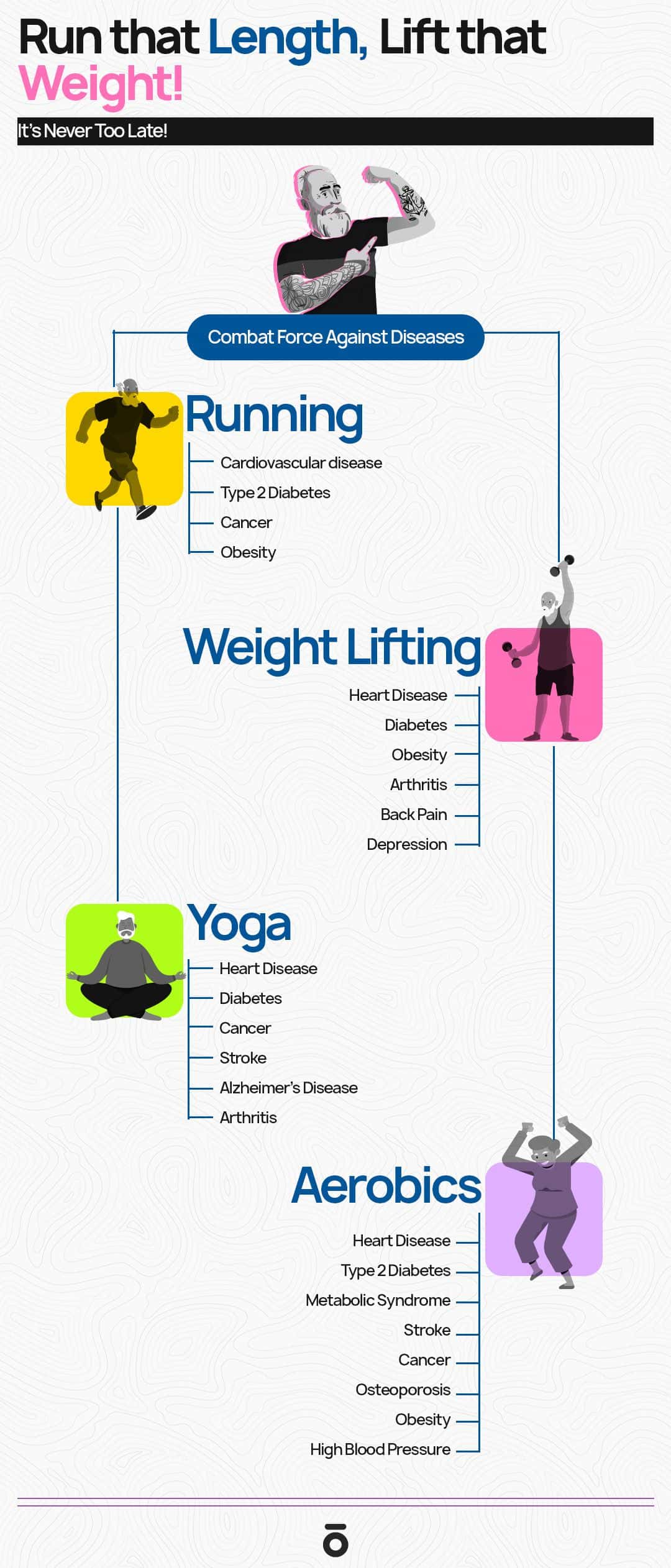Fitness for Older Adults - Mobility and Flexibility

Introduction
As we grow older, our fitness levels fall. We move slower and are more prone to injuries. Why does this happen? Well, it’s complicated. Firstly, our bones degenerate. They become brittle and weak. Secondly, we don’t heal so well. God forbid there’s a fracture - our healing time is much more than usual.
Not just the falls, there are so many underlying problems creeping up on you when your movement is limited. One of the primary results is weight gain. When you gain weight as an elderly, you carry the risk of diabetes, cardiovascular diseases, Arthritis, and many more.
Which is why it is very important that as a senior you perform some basic movements and exercises so your chances of falling are minimal, and you heal much better, even if you do suffer from a fall. Here are some mobility exercises for elderly.

The Exercise Guide to Remember
Walk
This is one of the best exercises that a senior can do. And the foremost, when it comes to flexibility training for older adults. Go for a brisk walk every morning. Walking loosens up your muscles and improves your health and well-being.
Walking helps you maintain your body weight and burn calories. It is also a great way to meet people or socialise. Walking can help prevent osteoporosis and osteoarthritis and reduce the risk of hip fractures.
Chair Squats
Squats are a great way to increase strength in your legs. However, as a senior, it might be difficult to perform a full squat. You need a gentle workout for seniors. We have to modify them.
Use a chair. Keeping the chair behind you, squat till you sit down. Stand up from this position. As soon as you stand up, sit down slowly, ensuring that your back is straight all the way down.
If you find this difficult to do, use an armchair. Squats strengthen your core and increase flexibility in your knees, glutes and calves while strengthening your bones, tendons and ligaments, making your knees stable. It can also protect your knees and hips so you can perform daily tasks with much more ease.
Wall Push-Ups
As a senior, doing regular push-ups is out of the question. Wall push-ups are your best friend in this regard. Wall push-ups strengthen your chest, shoulders, back, and arms and engage your core while improving your form and posture, helping you function better daily.
They also increase mobility in seniors. Wall push-ups bring down the strain on your joints and are good for beginners or people who find it difficult to do standard push-ups. This exercise is also helpful for mild wrist, elbow or lower back pain.
Moreover, wall push-ups increase stability by activating the stabiliser muscles in your midsection, which can help you stand and remain stable.
Plank
Planks strengthen your core muscles, including your abdominals and lower back. A strong core can help with bringing down lower back pain, improving your ability to do daily tasks, boosting athletic performance, ensuring your spine is neutral, and improving posture.
Planking can help increase your balance and flexibility and prevent injuries. Doing planks in the morning is great for your metabolism and can give you a boost of energy throughout the day.
Swimming
Swimming is a great way to strengthen all your muscles and get a good workout in, especially if you are a senior. It is a relaxing and peaceful form of exercise. It is good for coordination, posture and balance.
It improves flexibility and provides a low-impact therapy for certain injuries and conditions. As a senior, swimming could be one of the best ways for you to stay in shape and exercise all your muscles.
Do a regular freestyle stroke - and if you want to make this a little easier, use a float so you don’t strain your muscles. This is one of the best exercises for seniors.
Leg Raises
The abdominal wall has many parts, and it is vital that you exercise all of them. Leg raises are great for your lower abdominal muscles, groin and hip flexors, which are all very important for balance and mobility.
Lie flat on your back, placing your hands underneath your lower back for stability. Keeping your back straight, slowly lift one leg about six inches off the ground. Hold for around thirty seconds before repeating with the other leg.
Single-Leg Stands
If you want to improve your balance, the best way to do so is to practise balancing. Single-leg stands help build strength in the thighs as well as the stabiliser muscles that assist you in maintaining balance. Use a chair for stability.
Stand on one leg, keeping your knee slightly bent. Hold this position for at least a minute. As you get better, take your hands off the supportive chair for as long as you can. Standing on one leg is great for improving your balance.
As you get better, try standing on one leg for as long as possible so your balance improves. This is one of the best exercises for seniors.
Flexing Your Ankles
As a senior, it is very important to keep your ankles flexible because weak ankles are one of the most common complaints and can make orthopaedic issues much worse. Improving strength and mobility in the ankles improves balance.
Sit down on a chair, placing one foot as far out as you can, and rest the heel on the floor. Maintain this position, pointing the toe as far outward as possible then point it back towards the ceiling. Do this around 20-30 times with each ankle.

Conclusion
In conclusion, maintaining mobility and flexibility is extremely important especially if you are a senior. Exercises like single-leg stands, ankle-flexors, leg raises, swimming, walking, chair squats, wall push-ups and planks are extremely beneficial for you in terms of maintaining balance and flexibility. Because your senior years shouldn’t really be your twilight years. They should be the best years of your life.






